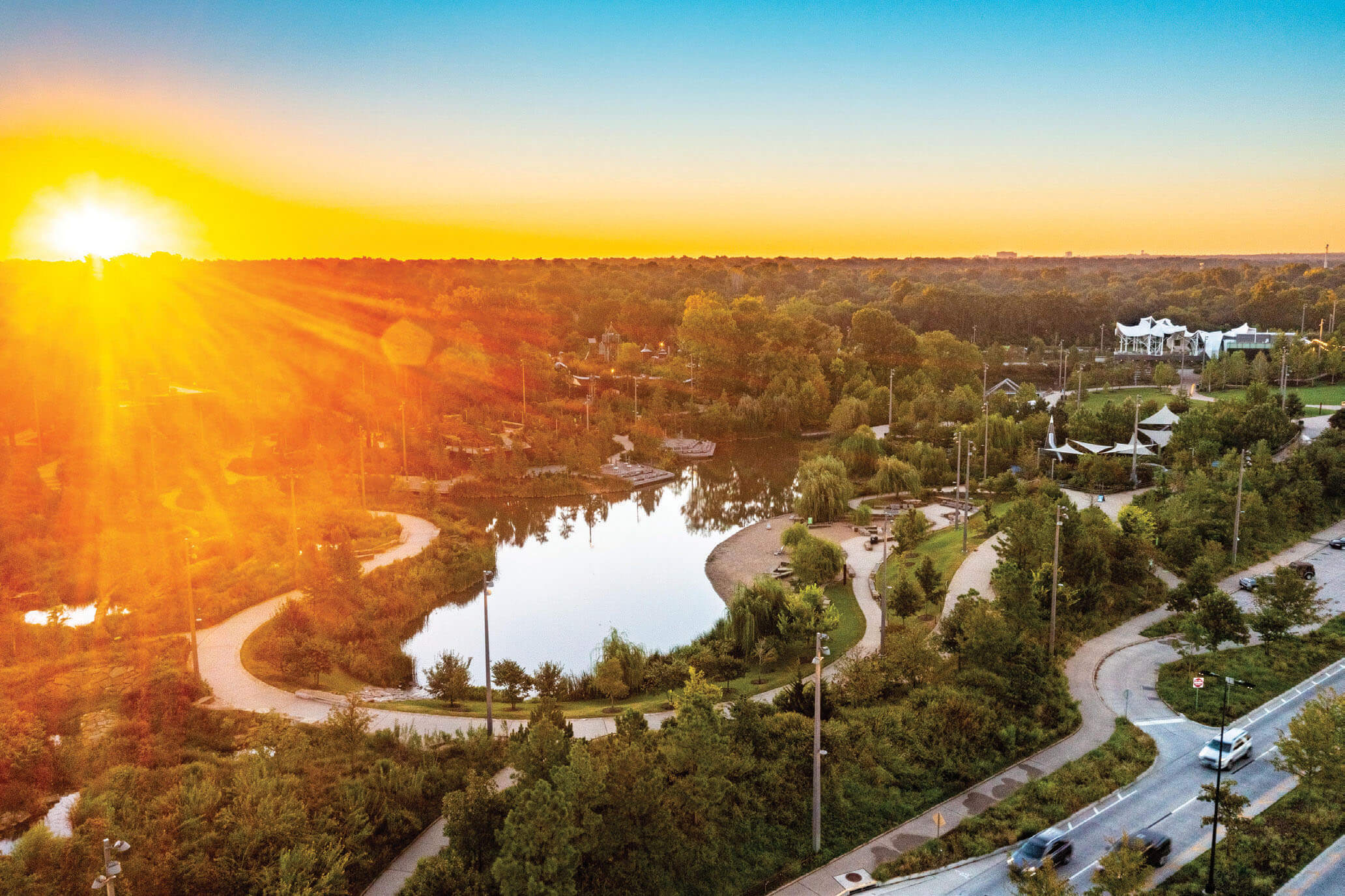
08 Mar Wanderings: Roaring Twenties Elegance in an Unexpected Place
Travelers expect to see Art Deco in Miami, L.A., and Chicago. Not in Oklahoma. But the sky-high pylons of marble, vertical chevrons, and abstract mosaics of downtown Tulsa are all the more delightful because of their unexpected setting.
In 1905, oil gushed from Glenn Pool Oil Reserve, vaulting Tulsa from a dusty cow town to the “Oil Capital of the World.” Twenty years later, across the world, the International Exhibition of Modern Decorative and Industrial Arts opened in Paris. This landmark exhibition introduced French Art Moderne to an international audience. Thrilled by the discovery of King Tut’s tomb, some of the French designers at the exposition combined ancient Egyptian themes with machinist details from the Industrial Revolution. Cubist art and jazz swirled in the background. Now called Art Deco, the new style was initially dubbed “zigzag.”
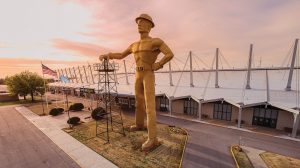
Created for the 1952 Petroleum Exposition, the Golden Driller statue is now Oklahoma’s official state monument. Photo courtesy of Impo Square
Waite Phillips, an oilman who thrived on art and vicissitude, brought the style to Tulsa, Oklahoma. His Philcade Building, with its Egyptian motifs, terracotta roofline, and explosion of gold leaf filigree, celebrates the Roaring Twenties. Architects followed his lead, and the Tulsa skyline began to climb. Terracotta and glazed brick geometric patterns zigzagged across the city.
Artist and teacher Adah Robinson and her architecturally minded student Bruce Goff designed the Boston Avenue Methodist Church, pairing modernity with religion. Described as “daringly new,” the stylized architecture — notably the oft-repeated abstract praying hands pointed towards the sky — still looks modern today.
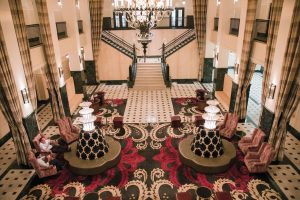
Built in 1925, The Mayo Hotel was the hub of Tulsa’s social scene until the 1980s. After nearly 30 years of vacancy, it was renovated and reopened in 2009, ushering in Tulsa’s age of revitalization. Photo courtesy of The Mayo Hotel
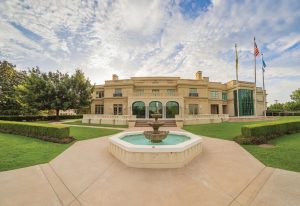
The Tulsa Historical Society and Museum, housed in a century-old Italian Revival-style mansion, features eight exhibit galleries of city history. Photo courtesy of the Tulsa Historical Society and Museum
Growing up in East Tulsa, Rachel Dazey often marveled at the Art Deco buildings downtown. Now an artist, she draws inspiration from those buildings. Dillon Rose, the jewelry company Dazey founded with her husband Seth, recently launched an Art Deco line, complete with Adah Robinson-inspired earrings. “She not only designed the church but all the stained-glass windows,” says Dazey. “She deserves a lot of credit that she doesn’t always get.”
The Art Deco line has long simmered in Dazey’s imagination. “I wanted to research, to understand what artists and architects were thinking,” she says. “Waite Phillips went to Europe 18 times to learn about architecture and import talent — such a wild investment in the culture of Tulsa.”
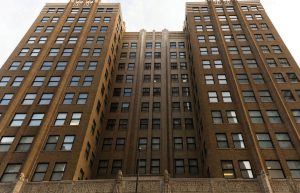
After building his 1928 Philtower, Waite Phillips crossed the street to build his next skyscraper: Philcade. Completed in 1931, it’s an early example of Art Deco’s zigzag architecture.
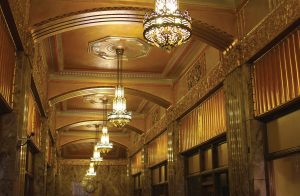
The gold and marble lobby of the Philcade is a nod to wealth and Egyptian influence. Photo courtesy of the Philcade
From Rise To Revitalize
After the Great Depression, buildings no longer pointed upwards but sprawled low and long as Art Deco morphed from zigzag to streamlined and then went completely out of style. Buildings designed to dazzle became home to vandals and squatters. Then, urban renewal bulldozers came along.
“By the late 1980s, much of Tulsa’s beautiful urban fabric had become a sea of asphalt,” says Amber Litwack, executive director of the nonprofit Tulsa Foundation for Architecture (TFA). The urban core had deteriorated, and once-spectacular buildings were scheduled for demolition. “Something had to change,” says Litwack. The first glimmers of change came in 1995 when architects and preservationists created TFA to preserve the built environment. Slowly, retrofitting crews replaced wrecking balls.
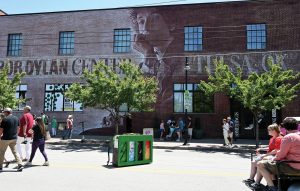
In 2016, Bob Dylan gave his archive of artifacts to the George Kaiser Family Foundation of Tulsa, stating that he “liked the casual hum of the heartland.” Now his collection is located next to the Woody Guthrie Center in Tulsa’s Arts District. Photo: Lester Cohen/Getty Images
The architecture firm Narrate Design has been a central figure in reviving Tulsa. In 2017, Whitney Stauffer, Hank Spieker, and Shane Aaron bought Selser Schaefer Architects and renamed the company Narrate. “The design narrative is part of every project we do,” says Stauffer. “The founders founded the firm on design and storytelling; this name is a great homage to them.”
Last fall, they moved into one of the oldest Art Deco buildings downtown and named each conference room after a Tulsa district. “We have signature projects in most of these districts,” says Stauffer. “Sometimes it just takes one building to build up a whole area.”
Recalling a 2007 revival of industrial warehouses, Stauffer says, “The 200 and 300 E Brady projects … both those buildings were catalysts for the Arts District. Nothing was down there yet. It was cool to partner with the visionary that started it all.” In 2012, the firm Narrate also designed the Hardesty Arts Center, the first flagship building in the district. The building was recently acquired by The University of Tulsa, renamed 101 Archer, and continues to feature gallery exhibits and weekly events. Narrate Design has been working with the University to adapt the space.
The Arts and Greenwood districts
Museums and creative spaces have multiplied in the shadow of Art Deco buildings. The Woody Guthrie Center reminds patrons how to kill fascism, and the historic music venue Cain’s Ballroom provides the soundtrack. In 2015, the Tulsa Artist Fellowship tasked contemporary artists with stimulating Tulsa’s arts community, which brought a pulsing energy to the scene. During the monthly First Friday Arts Crawls, red brick warehouses open rolling garage doors, and patrons stroll exhibits along loading docks. And the nearby Guthrie Green is packed with lawn chairs as dancers or musicians mesmerize crowds.
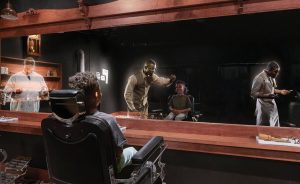
Before learning about the massacre, visitors to Greenwood Rising hear from post-WWI holographic barbers. Photo courtesy of Greenwood Rising
Narrate, along with the Tulsa Race Massacre Centennial Commission and exhibit designer Local Projects, created Greenwood Rising, a museum memorializing the 1921 Race Massacre in the Greenwood District. Museum visitors listen to holographic barbers discuss “Black Wall Street,” witness the violence of the massacre and a phoenix-like revival of the district, and are given spaces for reflection. Leaning on the strong legacy of Black entrepreneurship, the Greenwood District is a case study for revitalization. Black Wall Street was burned and rebuilt itself bigger and better. Today, visitors flock to historical sites, boutique stores, and restaurants in the area.
Route 66 and South Tulsa
While Tulsa’s Art Deco architecture is unexpected, its Route 66 nostalgia is familiar. Motorists shop for souvenirs at Decopolis Art Deco Museum, snap pictures of the Meadow Gold sign, and eat at Mother Road Market’s pop-up restaurants. For Route 66 aficionados, the Blue Whale of Catoosa, a beloved historic landmark in a once favored swimming hole for travelers along Route 66, is 15 miles away. And the Golden Driller statue, a 75-foot-tall, 43,500-pound statue depicting an oil worker, has been located in front of the Tulsa Expo Center since 1966.
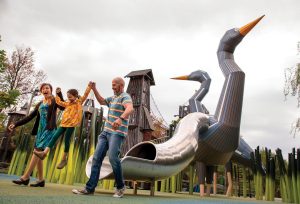
The Gathering Place has multiple adventure playgrounds, a sensory garden, a reading tree, and a mountain-themed splash park. It’s a must for anyone traveling with children. Photo courtesy of The Gathering Place
Westhope, a Frank Llyod Wright home with columns of glass windows and concrete blocks, is tucked into leafy suburbs. The house isn’t public, but it’s fun to glimpse while en route to Philbrook Museum of Art, set in the historic former home of Waite and Genevieve Phillips, with expansive formal gardens. Waite Phillips built the Renaissance-style villa and later gifted it to the city. The museum features a world-class art collection throughout the historic home and 25 acres of gardens.
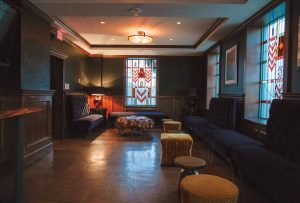
For the best rooftop bar in town, head to The Penthouse Bar at The Mayo Hotel. The cozy inside space spills onto an outdoor deck with 360-degree views of Tulsa. Photo courtesy of The Mayo Hotel
Tulsa’s latest treasure, Gathering Place, is a 66-acre park with playgrounds, a boathouse, and thoughtful programming. A drive along the Arkansas River passes another Bruce Goff creation, the Spotlight Theater, where America’s longest-running play, “The Drunkard & the Olio” is performed every Saturday.
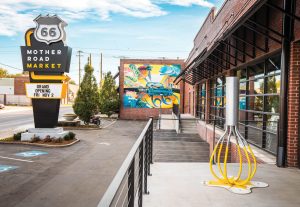
Find restaurants and market stalls inside a 1930s brick warehouse at Mother Road Market on Route 66. An outdoor patio behind the building and locally commissioned artwork make Oklahoma’s first food hall a fun experience. Photo courtesy of Mother Road Market
Whether checking out Tulsa’s Art Deco scene from the 1920s or enjoying neighborhoods that were revitalized in the 2020s, Tulsa is full of unexpected experiences worth exploring.
Jenna Vandenberg teaches, writes, and travels from her home base in Seattle.
Attractions and Events
Bob Dylan Center
918.392.3353; bobdylancenter.com
Cain’s Ballroom
918.584.2306; cainsballroom.com
DECOPOLIS Tulsa Art Deco Museum
918.382.7388; decopolis.net
Dillon Rose
918.873.0281; dillonrose.net
Gathering Place
918.779.1000; gatheringplace.org
Gilcrease Museum (closed for renovations until 2025)
918.596.2700; gilcrease.org
Greenwood Rising
539.867.3173; greenwoodrising.org
Magic City Books
918.602.4452; magiccitybooks.com
Philbrook Museum of Art
918.749.7941; philbrook.org
Spotlight Theater
918.587.5030; tulsaspotlighttheater.com
Expo Square
918.744.1113; exposquare.com
Tulsa Foundation of Architecture
918.583.5550; tulsaarchitecture.org/tours
Tulsa Historical Society and Museum
918.712.9484; tulsahistory.org
Vintage Vault
918.619.9954; vintagevaulttulsa.com
Woody Guthrie Center
918.574.2710; woodyguthriecenter.org
Dining
Amelia’s Wood Fired Cuisine
918.728.2435; amelias.us
Boston Title and Abstract
918.301.0744; bostontitleandabstract.com
Cabin Boys Brew Pub
918.933.4033; cabinboysbrewery.com/brewpub
Foolish Things Coffee Co
918.857.2326; foolishthingscoffee.com
La Tertulia
539.525.0853; latertuliarestaurant.com
Mother Road Market
918.984.9001; motherroadmarket.com
Mr. Kim’s
918.856.6456; fantasticmrkims.com
The Vault
918.948.6761; vaulttulsa.com
Valkyrie
918.508.2285; valkyrietulsa.com
Lodging
Ambassador Hotel
888.408.8282; ambassadortulsa.com
Hotel Indigo Tulsa
918.779.4445; ihg.com
Mayo Hotel
918.582.6296; themayohotel.com
Tulsa Club Hotel
918.582.5722; tulsaclub.com
Galleries
108 Contemporary
918.895.6302; 108contemporary.org
Lovetts Gallery
918.664.4732; lovettsgallery.com
The Hulett Collection
918.934.7240; thehulettcollection.com
Tulsa Art Gallery and Studio Guide
tulsago.com/explore/arts-culture/galleries-studios






No Comments